Introduction: What’s the Catch?
Ahoy, seafood lovers! Are you as confused as a fish out of water when it comes to distinguishing a halibut vs flounder? You’re not alone. Despite being two of the most popular flatfish in the culinary world, halibut and flounder often find themselves in a murky sea of identity confusion. Today, we’re going to “scale” down this topic and navigate the depths of differences and similarities between these two flatfish giants. Stick with me, and you’ll soon be the Captain Ahab of halibut and flounder knowledge!
Before we get into the meat of the article, here’s a quick reference to the main key differences of halibut vs flounder.
| Feature | Halibut | Flounder |
|---|---|---|
| Size | Large, up to 9 feet and 500 pounds | Smaller, usually around 12-20 inches |
| Habitat | Deep waters, usually 100 to 400 feet | Shallow waters, often between 10 and 50 feet |
| Fishing Gear | Heavy-duty gear with strong lines and large hooks | Light to medium tackle |
| Best Time to Fish | Early morning or late afternoon | Throughout the day, especially tide changes |
| Bait | Salmon heads, octopus, large jigs | Live bait like shrimp or minnows |
| Texture | Firm and hearty | Softer and more delicate |
| Flavor | Rich, sweet, and more flavorful | Mild and versatile |
| Cooking Methods | Grilling, frying, baking | Pan-frying, baking, sautéing |
| Culinary Uses | Steaks, grilling, high-end cuisine | Versatile, good for casual and formal dishes |
| Nutritional Benefits | High in protein and omega-3s | High in protein and omega-3s |
Table of Contents
What Are Flatfish, Anyway?
Before we dive into the Halibut vs Flounder duel, let’s talk flatfish. Flatfish are, well, flat! They have both eyes on one side of their head, which sounds like a joke Mother Nature played but is actually a brilliant adaptation for life on the ocean floor. Imagine lying on your side all day and still being able to keep an eye on your surroundings!

Halibut: The Heavyweight Champ
Physical Attributes
Halibut are the Arnold Schwarzeneggers of the flatfish world. These bad boys can weigh up to 500 pounds and span a whopping 9 feet. Their size makes them a favorite among anglers and Instagrammers looking for that perfect “big catch” photo.
They are protected in some areas and have to be a minimum size before you can catch them.
Culinary Profile
When it comes to taste, halibut is like the Rolls Royce of flatfish. It has a sweet, delicate flavor and a firm texture that holds up well to grilling, frying, and baking. The meat is white and flaky, almost begging to be seasoned and savored. Have you ever tried a delicious halibut steak with lemon-butter sauce? If not, let me tell you, you’re missing out on a life-altering experience.

Flounder: The Versatile Virtuoso
Physical Attributes
Flounder are generally smaller, but what they lack in size, they make up for in versatility. They’re the Swiss Army Knives of the flatfish world. A typical flounder measures around 12-20 inches.
Culinary Profile
Flounder has a softer texture and a milder flavor compared to halibut. Because of its versatility, flounder serves as an excellent canvas for a wide range of culinary adventures—from a simple pan-fry to an exotic curry. You might find flounder to be the “everyman” of fish, comfortable in casual and formal settings alike.
Halibut vs Flounder: The Key Differences
To summarize, here are the key differences between halibut and flounder:
- Size: Halibut are generally larger than flounder.
- Texture: Halibut has a firmer texture, while flounder is softer.
- Flavor: Halibut has a richer, sweeter taste compared to the milder flavor of flounder.
Hook, Line, and Sinker: Fishing Tips for Halibut and Flounder
So, you’ve learned about these intriguing flatfish and now you’re ready to head out and catch your own. Awesome! Whether you’re an angling aficionado or a beginner, here are some fishing tips to help you make the most out of your halibut and flounder fishing adventures.
Fishing for Halibut: How to Reel in the Big One
Deep Waters: Halibut love the deep, so aim for waters that are at least 100 to 400 feet deep.
Heavy Gear: Due to their massive size, halibut require strong, heavy-duty fishing gear. We’re talking high-capacity reels, strong fishing lines, and large, sharp hooks.
Bait: Halibut aren’t picky eaters. Salmon heads, octopus, and large jigs can all make effective bait.
Timing: Early morning or late afternoon are often cited as the best times to fish for halibut.
Technique: Drop your line to the bottom and then reel it up a few feet to ensure your bait is visible. Periodic jigging can attract attention.
Safety: Halibut are strong and can weigh hundreds of pounds. Always use caution when reeling one in and consider using a harpoon to secure your catch.
Fishing for Flounder: Mastering the Art of Subtlety
Shallow Waters: Unlike halibut, flounder are found in shallower waters, often between 10 and 50 feet deep.
Light Gear: Light to medium tackle is usually sufficient for flounder. Look for gear specifically designed for flatfish.
Bait: Live bait like shrimp or minnows tend to work best, although artificial lures can also be effective.
Timing: Flounder can be caught throughout the day, but many anglers swear by the hours surrounding the changing tides.
Technique: Cast your bait and let it sink to the bottom. Slow, steady retrieves work well. Some anglers like to use a “tap and pause” technique to mimic natural prey.
Patience: Flounder bites can be subtle, almost like a gentle tug. Be patient and wait for the fish to fully take the bait before setting the hook.
FAQs: Dive Deeper into Halibut and Flounder
What is the best way to cook halibut?
The firm texture of halibut makes it perfect for grilling, pan-searing, and baking.
Can I substitute flounder for halibut in recipes?
Yes, you can, but remember that flounder has a milder flavor and softer texture. You might need to adjust cooking times and seasoning accordingly.
Are halibut and flounder healthy to eat?
Both are excellent sources of protein and omega-3 fatty acids, which are beneficial for heart health.
Where can I buy halibut and flounder?
Check your local seafood market or consider purchasing them online from Amazon for added convenience.
The Final Catch
There you have it, folks—halibut and flounder, unmasked and laid bare on the filleting table of facts. Both have their merits, and neither is better than the other; it’s all a matter of taste and preference. But hey, why not catch both? After all, variety is the spice of life—or, in this case, the sea.
Happy fishing and even happier cooking!

